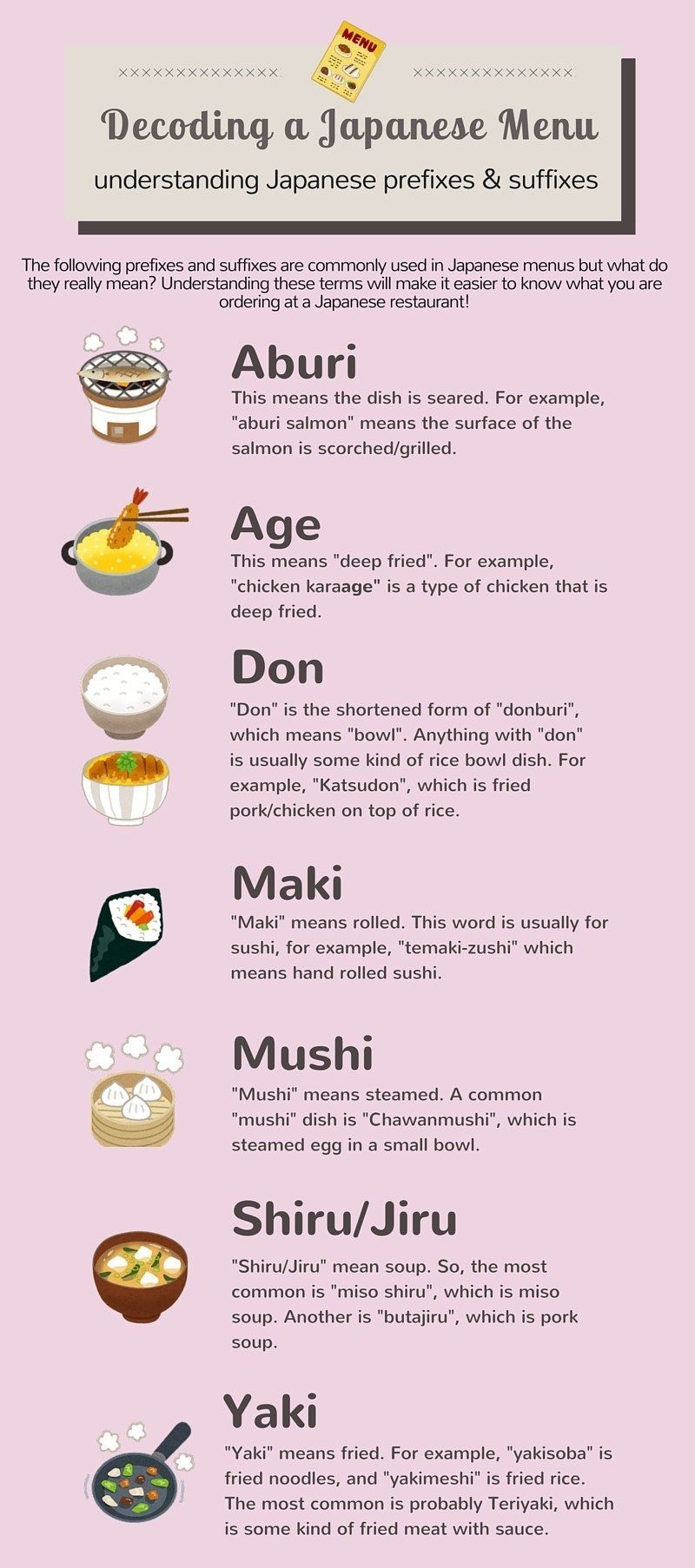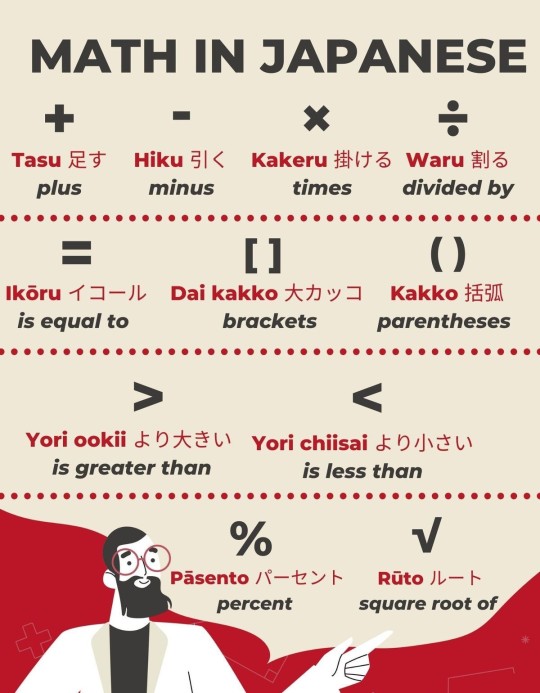Text
今日は夏の始まりです!

It's been a long time since I've been able to post on here, but for good reason! I went through my first semester in a REAL college Japanese class in the spring, and during that time (I was a full-time student) I was also super busy prepping for my job and moving.
Some really cool things that happened:
I pulled a 4.0, so I made it onto the dean's list:D
About halfway into the semester, I was invited to our Japanese Honor Society with the opportunity to join the Japanese National Honor Society once I graduate
At the end of the semester, I became the secretary for our Japanese Culture club!
The spring semester ended in May, so what have I been doing? Well, the school's summer study abroad trip got canceled, so a professor was available to teach a summer Japanese course. I decided to take it since it'll allow me to graduate a semester earlier and it'll open up the rest of the Japanese major classes, so I'll be able to take those next semester!
It's weird to say, but after next week, I'll be completely finished with Genki 2. After, we'll move on to a completely new textbook!
Well, that's my update for now! Hopefully, I can update again soon!
4 notes
·
View notes
Text
Will be posting a study log from 12/29 soon. This week is busy with working mornings, but hopefully I get to it before the weekend!
1 note
·
View note
Text
i don’t know why but i’m really amused by the winner of some ‘new kanji’ contest:
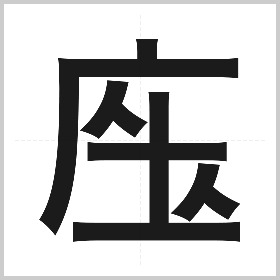
compare with the real kanji

座 (seat/gathering), but the two 人 (person) radicals have been moved from next to each other within the 土 (earth) radical to diagonally from each other, making this “social distance(d seating/gathering)”
92K notes
·
View notes
Video
OKAY BUT YOONGI’S VERSE JAPANESE VERSION
5K notes
·
View notes
Text
12/25 Homework

4 notes
·
View notes
Photo
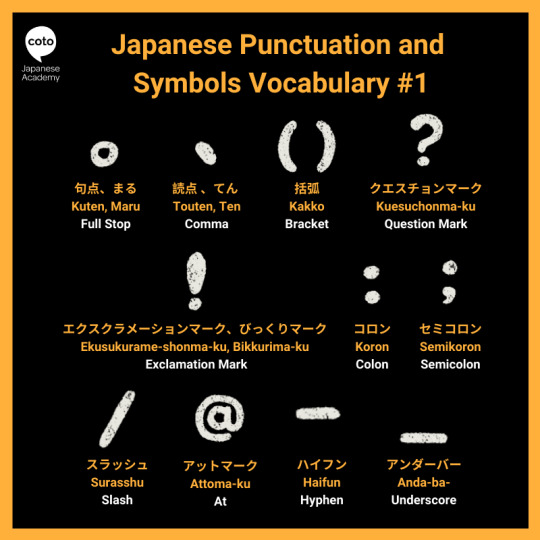

Learn the names of punctuation and symbols in Japanese!
651 notes
·
View notes
Text
How to Choose Japanese Manga/Books for Studying

In an ask recently, a user asked me what reading materials I recommend to study with.
I’ve covered the standard textbooks here, and today I’ll talk about how you can determine whether an authentic material is suitable for your studies. All of this advice is based upon my studies in SLA (Second Language Acquisition) and TESOL (Teaching English to Speakers of Other Languages), as well as my personal experience learning Japanese.
What’s an Authentic Material?
Authentic materials are print, video, and audio that are not classroom materials, but are things made for Japanese (or any other target language) speakers. A mock advertisement in your textbook is not an authentic material because it is not made for a Japanese person, but an actual Help Wanted ad in a Japanese newspaper is an authentic material.
Authentic materials can be just about anything audio or visual. Manga, light novels, newspapers, magazines, jpop songs, anime, news broadcast, etc.
Today I’m just going to focus on visual authentic materials, but if there’s interest I could make a future post about audio materials too.
1. Decide Your Method of Reading: Intensive or Extensive
When reading to study a foreign language, there are two different ways to go about it, intensive reading or extensive reading.
Intensive Reading
Reading and looking up every single word you do not know, even words that aren’t essential to understanding the main points of the story.
Pros: you learn a lot more vocab
Cons: it takes considerably longer to make progress
In order to do this method effectively (and by effectively I mean “resist chucking your book out the window in a fit of rage”), you must comprehend ~70%* of the content.
Extensive Reading
Basically what you do when you read in your native language. You read each page, and even if you come across a word you don’t know, you keep going. You only look up words that keep coming up, or that hinder your overall comprehension of what’s going on.
Pros: you cover more ground and get a bigger sense of accomplishment
Cons: you can miss out on smaller details
In order to do this method effectively, you must comprehend ~90% of the content.
Neither reading method is better than the other. Choose which style suits your personality best. Personally, I’m one of those people that has to know every last morsel about everything, so I only do intensive reading.

2. Determine How Difficult a Material Is
Up above I said you had to be able to comprehend either 70 or 90 percent of the content depending on the method you want to go with.
In extensive reading, you need to be able to understand almost all the words because you can’t stop to look up a ton of stuff. If you have to look up 15 words on a page because you can’t understand what’s going on, you’re not doing extensive reading–you’re doing intensive reading.
Now, as for the 70% I put on the intensive reading, there’s a bit of give with that, depending on how patient you are haha. If you’re okay with a crawling pace, the comprehension could be 10% if you want. But if you’re like me and you’re a bit hasty, you’re going to want to be able to comprehend around 70-80% of the vocab.
So how do you figure out how difficult the content is? Pick a random page and the first 100 words on it, and count the words you didn’t know. Subtract the words you didn’t know from 100, and the answer will tell you roughly how much you can comprehend of the text. Easy, right?
3. What Makes a Bad Material
I’m betting that anime/manga is what got most of us interested in learning Japanese, and there’s probably that one really nostalgic manga you’re dying to read in its original Japanese format.
I hate to be the bearer of bad news, but just because you love a series doesn’t make it a good learning material.
Things to Avoid in a Material
Lots of technical, scientific, or military jargon
I know that this wipes out a large swath of series, but the point of reading this is to learn Japanese, and there’s a good chance that most of the vocab you would learn would not be usable in conversation. Why waste the time learning 白刃取り (catching a blade between two palms) when you could be learning something more practical?
Period works (Edo Era and further back)
Many (but not all) period pieces contain a bunch of obsolete words, and the last thing you want to be is one of those gaijin that uses “gozaru” unironically. I tried using the expression 村八分 (ostracism) and got laughed at by my coworkers just last month because that just makes people think of villages in the Edo period.
Long Chapters
Particularly if you’re doing the Intensive Reading method, it’s important to give yourself a sense of accomplishment. It took me an hour to read one page of a book for one of my classes, and 30 hours to read ONE chapter. It was the most frustrating and endless experience I’ve had to date. Pick manga (because chapters are short) or short stories. (I really recommend Hoshi Shinichi’s “short-short” stories.)
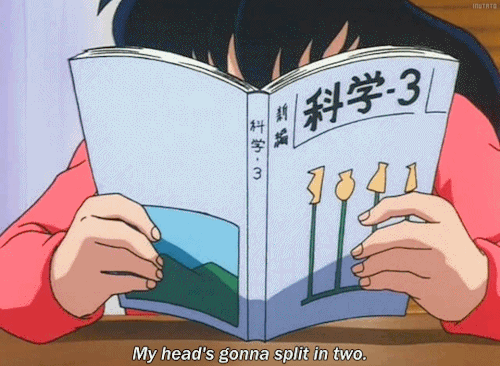
Don’t be like poor Kagome
4. What Makes a Good Material
I have saved the most important condition for your material until last.
Are you ready?
Here it is:
Make sure it’s something you like!
I know that this is so basic I shouldn’t even have to say it. But listen, for one of my Japanese courses in uni, I had a semester to read one of Haruki Murakami’s novellas. It was the most difficult and frustrating semester I had because not only was it super hard for me vocab-wise, it was boring as hell. I didn’t enjoy the story, and the ending was so
alskfjksldfjsd
It’s been 6 years and I’m still triggered. It was awful, and it made me feel like all of this toil, all of this suffering, had been for nothing. I thought that I hated reading in Japanese. But actually, when I pushed myself to try reading a manga I liked, I learned that I didn’t hate reading Japanese–
–I just hated reading Murakami.
If you find a material that is the right difficulty level and is appropriate for your purposes but you don’t find it interesting, it’s likely that you’ll get bored of it and quit halfway through. But if you like a material enough, even if it is too difficult for your current level, your love for it can give you the extra boost of motivation you need to push through it.
My favorite manga series of all time is Rurouni Kenshin. It was the first anime I ever watched, and it kinda started me down the road I’m on. So I decided to read the manga, and oh man is it a chore. I’ve read 14 volumes and have looked up 1,577 words as of today. It has a bunch of obsolete Japanese, it has so many sword words holy bejeezus (this is where I learned 白刃取り, btw), and it can take me hours to get through a chapter sometimes.
But I love that series with everything I am, so I don’t care how long it takes.
Really, what matters more than anything is that it’s something you are really invested and interested in.
5. How Soon Can I Start Reading Authentic Materials?
Did you know that the average native Japanese person cannot read a newspaper until they are a freshman in high school? That is how hard Japanese is. For the native speakers.
I hate to be a Debbie Downer here, but I would recommend you wait to use most authentic materials until you are N3 or N2. I finally began feeling comfortable reading stuff in Japanese around when I passed the N2. I understand that Chi’s Sweet Home is popular for beginners, so that isn’t to say that there are no authentic materials to be found for new learners, but they are very hard to find.
But hey, if you are determined enough, there is nothing that can stop you from reading what you love, and nothing worth having is easily won. Ganbatte!
1K notes
·
View notes
Text
Japanese vocab: Valentine’s day

バレンタインデー - Valentine’s day

ホワイトデー - White day
マシュマロデー - White day (Marshmallow day)
オレンジデー - Orange day or Partner day
彼女 - かのじょ - Girlfriend
彼氏 - かれし - Boyfriend
情 - じょう - Feelings, emotion, sentiment, passion, affection
感情 - かんじょう - Emotion, feeling, feelings, sentiment
デート - Date
プレゼント - Present
贈り物 - おくりもの - Present, gift
お土産 - おみやげ - Present, souvenir
飴 - あめ - Candy
キャンディー - Candy, sweets
チョコレート - Chocolate
義理チョコ - ぎりチョコ - Obligation Chocolate
本命チョコ - ほんめいチョコ - True feelings chocolate
友チョコ - ともチョコ - Friendship chocolate
薔薇 - ばら - Rose ( It can also be written in katakana: バラ )
花束 - はなたば - Boquet
縫いぐるみ - ぬ いぐるみ - Plush
テディーベア - Teddy bear
バレンタインカード - Valentine’s card
心 - こころ - Heart, mind, spirit
ハート - Heart
ロマンス - Romance
恋愛小説 - れんあいしょうせつ - Love romance, love story
恋 - こい - Romantic love
愛 - あい - Love, affection, care
恋愛 - れんあい - Love, love-making, passion
愛する - あいする - To love
… が 好きです。 - … が すきです。- I like …. (You can use 大好き・だいすき if you want to say: I really like…)
あなたが好きです - I like you
愛してる - あいしてる - I love you
キスする - To kiss
キス - Kiss
接吻 - せっぷん - Kiss, kissing
イチャイチャ - Flirting, making out
抱く - いだく - To hug, to embrace
寄り添う - よりそう - To get close, to cuddle close together
キューピッド - Cupid
- Dzseni

3K notes
·
View notes
Text
Japanese listening practice for beginners - Youtube videos
“キッズボンボン for Children” channel
All of the videos on this list have Japanese subtitles. It is mostly in ひらがな and the words are separated. This and the fact that these videos are aimed for children, makes them great for beginners.
PEACH BOY - MOMOTARO (JAPANESE) Japanese classical stories | fairy tale
KINTARO (Japanese) Japanese classical stories | fairy tale
USHIWAKAMARU (JAPANESE) Japanese classical stories | fairy tale
SHINING PRINCESS (JAPANESE) Japanese classical stories | fairy tale
THE TONGUELESS SPARROW (JAPANESE) Japanese classical stories | fairy tale
THE DANCING KETTLE (JAPANESE) Japanese classical stories | fairy tale
THE STORY OF THE MONKEY AND THE CRAB (JAPANESE) Japanese classical stories | fairy tale
CLACK CLACK MOUNTAIN (JAPANESE) Japanese classical stories | fairy tale
OLD MAN WITH THE LUMP (JAPANESE) Japanese classical stories | fairy tale
OLD MAN FLOWER (JAPANESE) Japanese classical stories | fairy tale
THE YOUNG MONK IKKYU (JAPANESE) Japanese classical stories | fairy tale
THE GRATEFUL CRANE (JAPANESE) Japanese classical stories | fairy tale
URASHIMA TARO (JAPANESE) / うらしまたろう - 浦島太郎(日本語版)Japanese classical stories | fairy tale
THE SNOW WOMAN (JAPANESE) Japanese classical stories | fairy tale
THE ROLLING RICE BALL (JAPANESE) Japanese classical stories | fairy
INCH BOY (JAPANESE) Japanese classical stories | fairy tale
THE CHILD GODS (JAPANESE) Japanese classical stories | fairy tale
THE STORY OF THE ZODIAC (JAPANESE) Japanese classical stories | fairy tale
All of these videos have an English version on this channel. Search for them or click on this playlist. You can use both versions to study what’s being said.
SNOW WHITE (JAPANESE) fairytale | Folktales | bedtime stories
THUMBLINA (JAPANESE) | Folktales | bedtime stories
JACK AND THE BEANSTALK (JAPANESE) | Folktales | bedtime stories
PETER PAN (JAPANESE) | Folktales | bedtime stories
A DOG OF FLANDERS (JAPANESE) | Folktales | bedtime stories
PINOCCHIO (JAPANESE) | Folktales | bedtime stories
PUSS IN BOOTS (JAPANESE) | Folktales | bedtime stories
ALADDIN AND THE MAGIC LAMP (JAPANESE) | Folktales | bedtime stories
THE WOLF AND THE SEVEN LITTLE GOATS (JAPANESE) | Folktales | bedtime stories
CINDERELLA (JAPANESE) | Folktales | bedtime stories
THE LITTLE MATCH SELLER | Folktales | bedtime stories
HE MERMAID PRINCESS | Folktales | bedtime stories
LITTLE RED RIDING HOOD | Folktales | bedtime stories
THE THREE LITTLE PIGS (JAPANESE) | Folktales | bedtime stories
THE ADVENTURE OF TOM SAWYER (JAPANESE) | Folktales | bedtime
THE WIZARD OF OZ (JAPANESE) | Folktales | bedtime stories
THE UGLY DUCKLING (JAPANESE) | Folktales | bedtime stories
ALICE IN WONDERLAND (JAPANESE) | Folktales | bedtime stories
All of these videos have an English version on this channel. Search for them or click on this playlist. You can use both versions to study what’s being said.
10K notes
·
View notes
Text
12/25- Going over ~たり~たりする from Chp. 11

I keep getting so excited as each of my Japanese lessons pass. It’s extremely challenging, but I feel accomplished when I can put more and more difficult sentences together. It’s really showing me how far I’ve gotten in the language!
What we did this time around:
-We spent a lot of time doing introductory practice, and in doing so, I got a lot of practice talking about things I want, things I want to do, and things I want other people to do.
-Went over the homework from our last lesson.
-Spent so much time going over ~たり~たりする.
Class notes/ extra vocabulary:
ねんまつねんし:New Years Time
つまらない:Boring
いわう:To celebrate
そのよる:That night
やくにたす:To be useful
つかう:To use
えをかく:To draw
どうが:Video
今のところ:So far
りょほう:Both
じつは:Actually
~による:To depend (needs a factor to depend on)
スピーカー:Speaker (the sound system type)
さつまいも:Sweet Potato
つかう:To use
つくる:To make
まだ(+affirmative):Still
ほかに:What else/Other
ターキー:Turkey
If you are going to use の to identify a previously talked about noun, you have to add an adjective or pronoun to it. (Example: 私は新しいスマートフォンがほしかったから、 クリスマスに母に新しのもらいました。)
~たり~たりするis what you use when you are listing things out of order. To use ~たり、 you have to put a verb in た-form and add り. You can use as many verbs with ~たりas you want, but it always ends with ~たりする, and this is where you show tense and if it is affirmative or negative.
~たりする can also be used when only listing one thing if there are other things to insinuate. (Ex. 私は友だちとあそんだりします。)
With ~たり~たりするyou can make things more complicated by adding past grammar for things like “I want to ~,~, etc.,” “I am good at ~,~, etc.,” “I like to ~,~, etc.,” “I am planning on ~,~, etc.,” all of which can be past, affirmative, or negative.
おそくまで起きる:To be up until late
か:Or
かんこうする:To sightsee
うるさくする:To be loud
そと(外):Outside
きたなくする:To make a mess/ to be messy
たのしむ:to enjoy
I have some homework sentences that aren’t from the workbook that my tutor gave me. They’re translation sentences; eleven in total. I plan on setting my next lesson for this coming Monday!
4 notes
·
View notes
Text
Study log (x2)- 12/10 & 17- Finishing Chp. 10 and Starting Chp. 11
Hey there! Well, I got crazy busy with my school application and work, so I ended up skipping doing a study log for my last tutoring session. Good news, though: after doing the late application, I was accepted into the Texas school I mentioned in previous posts! It was really cool; I was anticipating the deliberation on their end to take at least two weeks, but once they had all of my transcripts, I was accepted within three hours! Sorry in advance for forgetting most of the context for random vocabulary we covered on the 10th. Anyways, onto my tutoring notes!
12/10
What we did this lesson:
- Did a quick catch-up as warm up! I filled my tutor in on my plans for school and how I won’t be moving like I originally planned.
- Went over the homework, which went pretty well, but there was a whole section he had accidentally assigned that we hadn’t covered yet. I attempted it still, but my answers sounded so weird! (emoji)
- We learned how to use かかる and how to respond to どうやって行きますか。
- Finished up with a review over all of chapter 10!
Class notes/ extra vocabulary:
よやく:reservation
いっぱい:full/ enough (ex. The barber had no availabilities)
とこや:barber
かみがた:hair style
よぶ:to call (in context of, “The barber called me.”)
おわる:to finish or complete
たんい:school credit
がくい: degree (the school version, not weather)
ぎりの父:stepfather
そふ:grandfather (your own)
そば:grandmother (your own)
そふば:grandparents- this one is really cool because it’s just the two vocabulary words put together!
どのぐらいあっていませんか:How long has it been since you’ve seen them? (literally: how long haven’t you seen them for?)
か月:counter for months
はんとし(半年):half a year
びっくりする:to be surprised
きもちわるい:gross/ creepy/ disgusting (apparently the hotel my tutor was staying at had bed bugs🤢)
気まずい:awkward
かかる:to take time. Place A から Place B まで amount of time かかります。(It takes this long to go from Place A to Place B.)
しゅかん:week counter
If you use かん as a time counter, you don’t use に.
で:by way of (when talking about transportation)
あるいて:on foot- this is the てform of to walk, and does not require the use of で.
こわれる:broken (in the context of ‘the air conditioning in my work van is broken’)
エアコン:air conditioner
どうぐらいかかりますか。:How long does it take?
どうやって行きますか。:What method of transportation did you take?
どうやって:method
ちかてつ:subway
ふね: ferry/ship (bigger than regular boat)
ちょっこうびん:direct flight
どこでも/どこにも: used for I take my car everywhere
12/17
What we did this lesson:
- Our warmup was discussing what I did earlier in the day.
- Went over the homework.
- Learned how to say, “I want to (a verb),” “I want (a thing),” and, “I want someone to (a verb).”
Class notes/ extra vocabulary:
よやくをするor よやくをとる:to make an appointment. (This is the same よやくthat was used in the previous lesson, but in this case, I was using it to say I had a zoom meeting with an advisor.)
もの:things (tangible)
こと: things (intangible)
学校のことで忙しいです。:school things (in context: I was busy with school things.)
で:particle used to give reason
きもち:feeling/ mind/ what you think
かわる:to change
気持ちがかわりました:I changed my mind (in context: I changed my mind about which school I wanted to go to.)
あと:Also- Used at the beginning of a sentence. (In context: Also, I plan on spending time with my friend.)
ねんまつねんし:The New Year holidays (December 30th- January 3rd)
おおみそか:New Year’s eve
りょしん:Parents
めんどうを見する:To look after
おしょうがつ:New Year
けす:To erase something yourself
きえる:Something disappears. (*This would be used when you say the power went out. I tried to use けす when I was doing my homework to say that the power was out at work, but it sounded like I turned off the power myself.)
I WANT TO VERB :Stem of verb + たいです。(Ex. I want to study Japanese- 私は日本語を勉強したいです。) To negate a sentence like this, たい acts like an い-adjective, so it would become- 私は日本語を勉強したくないです。) Past tense たい→ たくなかった.
おまつり:Festival
ならう:To learn
しょうらい:In the future
げんご:language ( In context of: I want to be a language teacher.)
か:or (Ex. しょらい、言語かれきしの先生になりたいです。)
せいせき:grade
いじわる:mean
TO WANT A THING:~がほしいです。ほしい→い-adjective, so it conjugates the same way.
TO WANT SOMEONE TO VERB:someone+ に +てform verb+ ほしいです。*There are two ways to negate a sentence like this, either using (1) ない form in ほしいor (2) by using ないform +で.
(1) 私は父に私の食べものを食べてほしくないです。
(2) 私は父に私の食べものを食べないでほしいです。
どうりょう:coworkers
子どもの時から、父がゲームをするのを見ています:Since I was a child, I watched my father play video games. (This also uses の to make the verb into a noun.)
きたなくする:to make things dirty/ to make a mess
ギリシャ:Greece (the country)
My next class is scheduled for Tuesday, the 22nd. I’ll have to go over the vocabulary more for chapter 11 and do the first page of the workbook homework. I’m feeling better about getting through chapter 12 before my next school course starts. Also- a potential problem: I can’t register for classes until after I do orientation which is scheduled for the 4thof January. Because of this, I might not be able to sign up for a full-length semester of Intermediate Japanese and may be forced into do a 3-week intensive May-mester course. If this is the case, I’m going to try to continue with my tutor at this pace, and hopefully that will help me get ahead.
0 notes
Text
Attn: Study log coming Sunday!
This one will include two tutoring sessions that I did! Still trying to stick to two lessons a week until I can get through Genki I. My Word application keeps freaking out on me when I switch between the hiragana keyboard and the English one, so it’s been a slow process to get everything written up.
Also, I’m debating on whether to do everything all together in one post or two separate posts? For the first class, I didn’t take great notes, so I forgot the context of some vocabulary by the time I started writing the post. If you have an opinion on it, let me know!
1 note
·
View note
Text
ah yes, my favourite foreign language feel, “I know what all of those words mean individually but not together like that”
212K notes
·
View notes
Text
Ateji 当て字
Aside from 音読み (おんよみ) and 訓読み (くんよみ), there is a type of kanji reading called 当て字. This reading is the phonetic reading of a character, and there are three types.
1) The first type are words that use the phonetic reading of the characters. This is common in the kanji names of foreign countries. The names of countries were written using kanji that matched the phonetic pronunciations. The shortened versions today come from those original names.
America was written 亜米利加 (あまいりか) ➡ 米国 (べいこく) - rice
France was written 仏蘭西 (ふらんす) ➡ 仏国 (ふっこく) - Buddhism
Thus, the kanji associated with these two countries don’t necessarily relate to the countries themselves, but to the 当て字 used to write them. Most country names are now written in katakana.
America 亜米利加 (あまいりか) ➡ 米国 (べいこく) ➡ アメリカ
France 仏蘭西 (ふらんす) ➡ 仏国 (ふっこく) ➡ フランス
Portugal 葡萄牙 (ぽるとがる) ➡ ポルトガル
寿司 (すし) is also an 当て字 word, which is why the word is made up of the characters for longevity and government official.
2) The second type are words that borrow the meaning of the characters but not the reading. These words derive from words that existed in Japanese before kanji were conscripted, and since there was no existing character for that word they borrowed a different kanji.
Tobacco (煙草 - たばこ) is made up the characters for smoke and grass, and the reading matches the loanword from the Portuguese, who brought it to Japan. Today it’s normally written in katakana.
Shrimp (海老 - えび) and seaweed (海苔 - のり) are also this type of 当て字.
3) The third type of 当て字 use both the reading and the meaning of the word. This comes from kanji that already matched the reading and meaning of words (usually foreign).
合羽 (かっぱ) is the one that you usually learn in Japanese class. This word means raincoat and was introduced by the Portuguese (capa). The kanji for join and wings were selected to make this word - apparently it reflects a bird’s wings coming together to protect from the rain - and the reading already matched.
Today, most foreign loanwords are written using katakana, so 当て字 words are usually from before the Meiji Era. Most country names and words like tobacco are written using katakana now, but you still see the kanji names of countries in the news.
当て字 in Names
当て字 is also commonly used in names. When parents select a name for a child, they want auspicious kanji that will match the reading but provide a meaning that will bring luck, make them a good person, or even have an auspicious number of strokes in the whole name.
Personal Note: In my husband’s family, the parents traditionally go to a fortune teller/priest to select a name that matches the future predictions for the child, will bring good fortune, and has an auspicious number of strokes including the last and first name. My husband and brother-in-law both had their names and kanji selected by the priest. My sister-in-law let the priest select her daughter’s name and kanji, but we wanted a particular name for our son and so we told him the name we had in mind and then he selected the kanji that best match the reading and last name. My husband, son, brother-in-law, and niece all have 当て字 in their names because of this selection process.
265 notes
·
View notes

